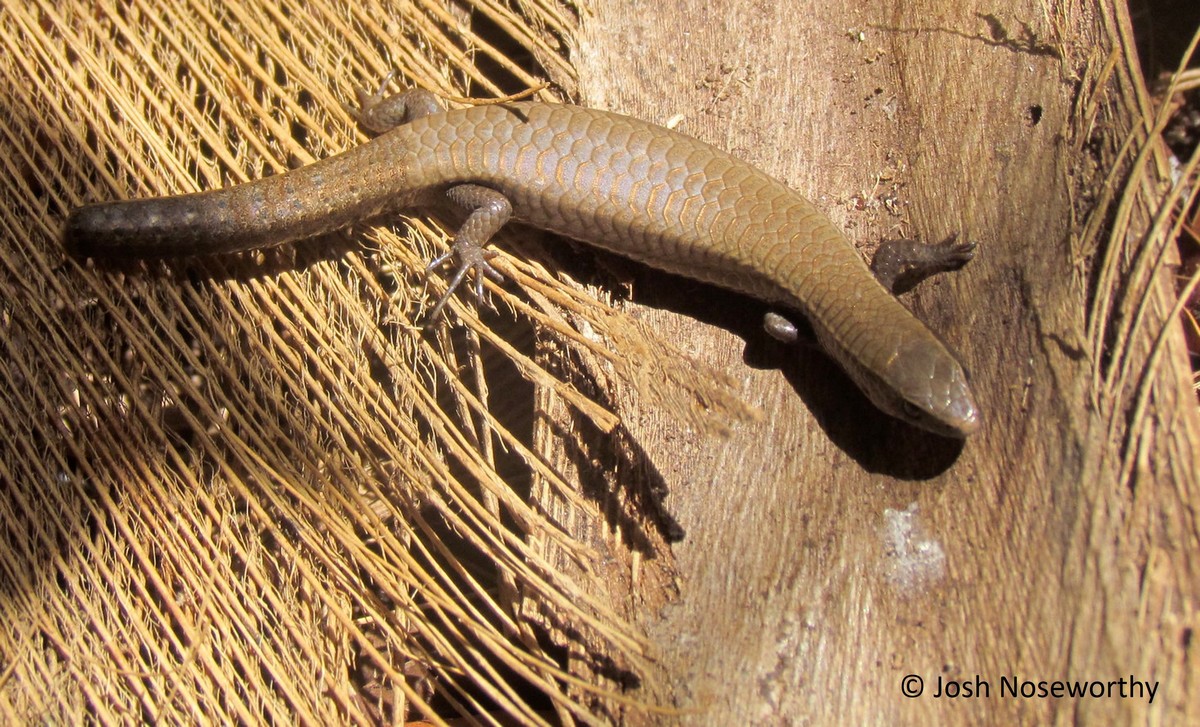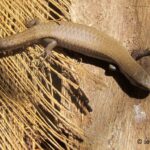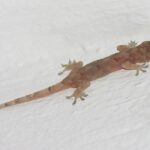
- Scientific name : Gymnophthalmus underwoodi (Grant, 1958)
- Common name : Underwood’s spectacled tegu, Smooth-scaled Tegulet
- Order : Gymnophthalmidae
- Family : Squamata
Description
Morphology. Small sized lizard with elongated body and tail. The dorsal side is brown, with a pale lateral line extending from the snout to the tail, passing over the eye. Below this line the scales take on a darker colour. The ventral side is whitish, with dark spots (Cole et al., 2013; Recoder et al., 2018; van den Burg et al., 2021).
Standard body size (snout-vent length). up to 43 mm (Turk et al., 2010; Recoder et al., 2018; van den Burg et al., 2021)
Sexual dimorphism. No sexual dimorphism (unisexual species) (Cole et al., 1993; Kizirian et Cole, 1999).
Variations.
Possible confusion with other species. Confusion is possible with a close related species native to Guadeloupe, Dominica, Martinique and Saint Lucia, Gymnophthalmus pleei. G. underwoodi is distinguished by a relatively keeled tail, resulting in a lower number of scales below the tail (Recoder et al., 2018).
Distribution
Native. Venezuela, Guyana (Cole et al., 2013), Surinam (Jairam, 2016), Guyane, Brazil (de Oliveira et al., 2014; Ribeiro-Junior et Amaral, 2016, 2017; Recoder et al., 2018; Farias and Vogt, 2020).
Caribbean: Grenada, Saint Vincent and the Grenadines (Daudin et Silva, 2007; Powell et Henderson, 2017; Recoder et al., 2018), Trinidad, Tobago (Auguste, 2019), Barbade (Ribeiro-Junior et Amaral, 2016, 2017).
Introduced. Florida (van den Burg et al., 2021).
In the Caribbean, the status of native or introduced species is not clearly established for all populations.
Caribbean: Cuba (Borroto-Páez et al., 2012), Dominican Republic (Szkudlarek, 2019; Reyes et al., 2020), US and British Virgin Islands, Antigua, Barbuda (Censky and Lindsay, 1997; Daltry, 2011), Saint Martin, Saint Kitts, Nevis, Saba, Montserrat, Saint Barthélemy (Questel and Boggio, 2012; van den Burg et al., 2021), Guadeloupe (Lorvelec et al., 2007; Breuil, 2010), Dominica (Turk et al., 2010), Martinique (Lorvelec et al., 2007; Breuil, 2010).
Biology and ecology
Habitat. Gymnophthalmus underwoodi inhabit a wide diversity of natural and anthropized habitats. The species is observed in humid and dry forests, river beaches, rocky slopes with low vegetation or in gardens and peri-urban areas (Ribeiro-Junior and Amaral, 2017; Recoder et al., 2018; van den Burg et al., 2021).
Diet. Insectivore (Powell and Henderson, 2017).
Reproduction. G. underwoodi is a parthenogenetic species, meaning that females lay eggs that develop without the need to be fertilised (Cole et al., 1993; Kizirian and Cole, 1999).
Reproduction happens throughout the year, and females produce one to four eggs per clutch (Kalaisko 2015).
Behaviour.
Impact and management of introduced populations
Impact. Little is known about the impact of Gymnophthalmus underwoodi on native ecosystems in introduced regions.
Management. To date, no targeted control measures have been established in the different regions where the species has been introduced.
The status of native or introduced species is not clearly established for several populations in the Caribbean (Lorvelec et al., 2007).
Bibliographie
- Giannasi, N., Thorpe, R. S., & Malhotra, A. (1997). Introductions of anolis species to the islan of St. Lucia, West Indies: testing for hybrids using multivariate morphometrics. Journal of Herpetology, 31, 586–589.
- Gorman, G. C. (1976). Observations on the distribution of Anolis extremus (Sauria: Iguanidae) on St. Lucia, West Indies: a “colonizing” species. Herpetologica, 32, 184–188.
- Losos, J. B. (1996). Dynamics of range expansion by three introduced species of anolis lizards on Bermuda. Journal of Herpetology, 30, 204–210.
- Murphy, J. C., Downie, J. R., Smith, J. M., Livingstone, S. M., Mohammed, R. S., Lehtinen, R. M., … Jowers, M. J. (1997). A field guide to the Amphibians & Reptiles of Trinidad & Tobago (R. J. Auguste, ed.). Malabar, Florida: Krieger Publishing Compagny.
- Nummelin, M. (1997). Seasonal occurrence of juvenile Anolis extremus Garman in forest patches in Barbados. Journal of the Barbados Museum and Historical Society, 43, 24–31.
- Rivas, G. A., Molina, C. R., Ugueto, G. N., Barros, T. R., Barrio-Amorós, C. L., & Kok, P. J. R. (2012). Reptiles of Venezuela: An updated and commented checklist. In Zootaxa, 64.
- Williams, R. J., Morton, M. N., Daltry, J. C., & Toussaint, A. (2019). The distribution of non-native Anolis lizards on Saint Lucia, Lesser Antilles. Caribbean Journal of Science, 49, 281.





